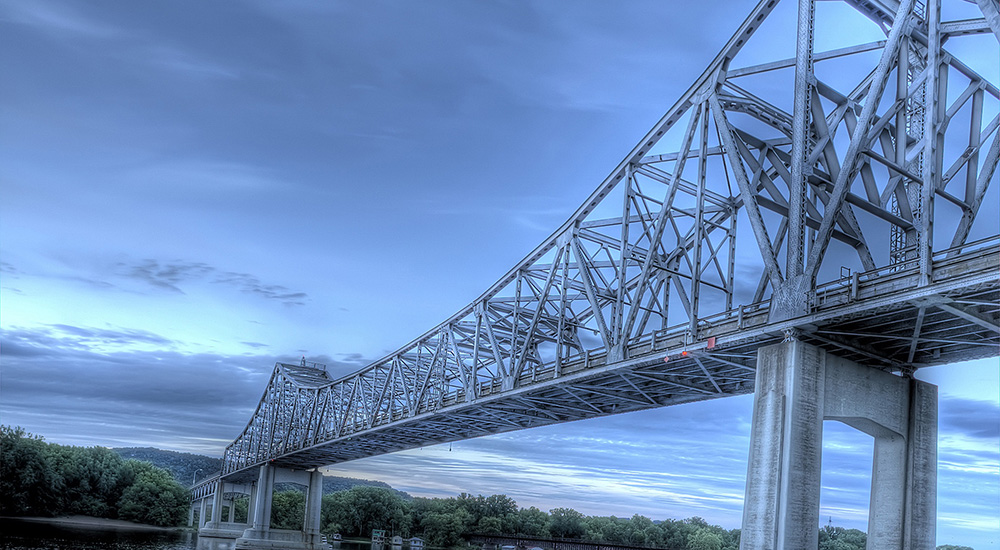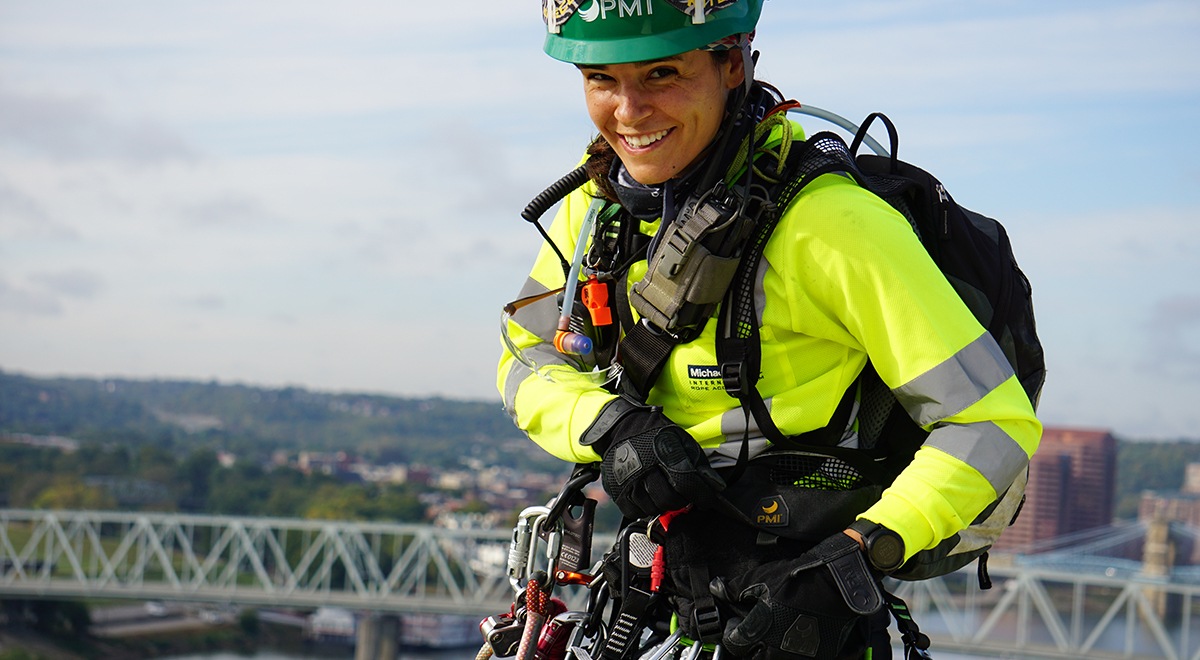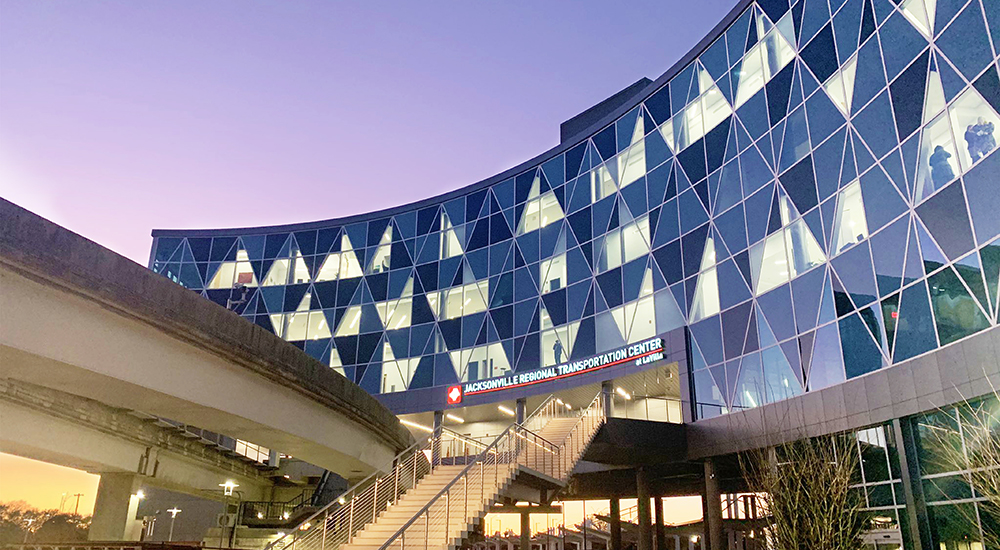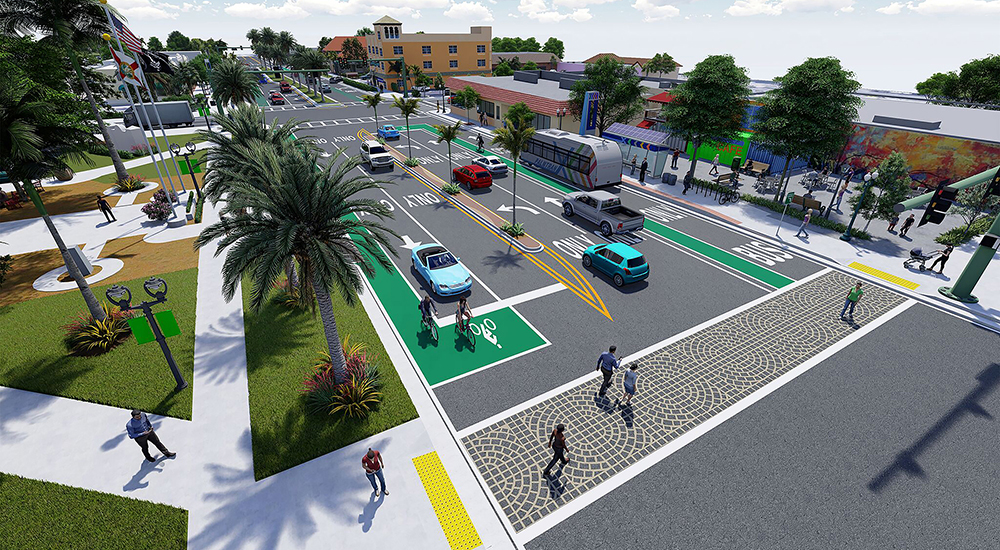Michael Baker International rehabilitates a historic Minnesota bridge
From the 80th Anniversary Edition of Signature
The Winona Bridge is a magnificent structure. It carries Trunk Highway 43 across the Mississippi River, linking the bustling inland port of Winona, Minnesota, and the state of Wisconsin. Constructed in 1942, the 2,288-foot bridge is an iconic historical artifact, Minnesota’s only surviving prewar cantilever-through-truss bridge. As such, the iconic span has been named to the National Register of Historic Places.
The bridge is just as important to the region’s economy, carrying approximately 12,000 vehicles per day, a heavy volume that includes commuters and cargo-shipping trucks. It also serves as a lifeline for a number of Wisconsin towns that depend on a Winona-based ambulance service — and thus the bridge — for emergency response. In these ways, the bridge has been a bulwark of history and commerce.
By 2014, the Winona Bridge had experienced significant deterioration and was in need of significant rehabilitation. The bridge had been posted to prohibit heavier modern permit vehicles from utilizing this key crossing. Could a renovation/modernization project feasibly extend the venerable span’s service life by 50 years while still maintaining its historic status?
This is the story of how Michael Baker International partnered with the Minnesota Department of Transportation (MnDOT) and Ames Construction to design and implement a strategy that added 50 years to the productive life of the grand old structure.
TOUGHER STANDARDS IN THE WAKE OF TRAGEDY
August 1, 2007, was a key date for the Winona Bridge — for all bridges in Minnesota, in fact. It was on that tragic day that the I-35W Bridge in Minneapolis collapsed, making national news. Prompted by that disaster, the Minnesota Legislature enacted Chapter 152 of the state Bridge Improvement Program, which requires incorporating redundancy on state-owned bridges.
A 2008 inspection concluded that the Winona Bridge was experiencing significant deterioration. A load limit was imposed on the bridge, which soon was closed temporarily for emergency repairs, forcing motorists to detour 60 miles or more round trip to alternate crossings. Although the shutdown lasted only 11 days, the local chamber of commerce estimated it cost the regional economy millions, an indication of how vital the structure is.
After considerable study, MnDOT, which maintains the bridge for the state, determined that the Winona Bridge could be upgraded to satisfy the tougher standards imposed in the wake of the I-35W Bridge tragedy.
Due to increasing traffic volumes, the impacts of a detour and the complexity of the bridge rehabilitation work, the state would also need to construct a new parallel bridge; ultimately, the companion bridge would carry westbound traffic exclusively, but it would carry all traffic during rehabilitation of the original structure. Once traffic was shifted to the new span, MnDOT could then implement a large number of complex repairs to the historic bridge.
It was an ingenious, elegant solution, but according to Keith P. Molnau, Major Bridge Projects Engineer in MnDOT’s Bridge Office, it didn’t spring to the agency full blown.
“We realized there was no way we could rehabilitate the Winona Bridge under traffic,” Molnau says, “and a detour was unacceptable. We started to go through the exercise of pricing a temporary bridge and had conversations with the U.S. Coast Guard about navigational issues. When we determined that a temporary bridge would cost $30 million to $40 million, we realized we would be better off building a permanent bridge.”
AN INNOVATIVE APPROACH TO PROCUREMENT
In 2014, MnDOT engaged Michael Baker as the Engineer of Record and Ames Construction as prime contractor for the rehabilitation. The near-simultaneous hirings were enabled by another legislative act that authorized use of a Construction Manager/General Contractor (CMGC) approach through which the designer and contractor work as a team, under the direction of MnDOT, from the outset.
This marked the first-ever use of CMGC for MnDOT — indeed, it had never been tried before by any Department of Transportation in the Midwest. Thanks to that approach, Michael Baker and Ames were able to collaborate, which resulted in a reduced construction cost, improved constructability, and enabled the construction schedule to be reduced. Says Kent Zinn, P.E., S.E., Great Lakes Regional Director for Michael Baker who served as the Project Manager:
“It’s a unique procurement method that has the designer and the contractor collaborating during the design stage while they both work simultaneously for the owner. It allows the owner to retain more control over the process while encouraging innovative construction ideas.”
Daniel Baxter, P.E., S.E., Michael Baker’s Bridge Department Manager in Minneapolis, notes that CMCG also facilitates cost control.
“It allows the owner to get more pricing information before the project is bid,” Baxter says. “There’s a lot more price and schedule certainty for the owner before the project is bid and it’s too late.”
STEEL PLATING FOR REINFORCEMENT
The companion bridge never was formally named — MnDOT refers to it by the nondescript moniker Bridge 85851 — but its importance was enormous. When the parallel span opened in 2016, all vehicular traffic was diverted to it, enabling the Michael Baker-Ames team to focus on rehabilitation and upgrading of the original bridge. The primary goal was to completely reconstruct the deteriorated approach spans, replace the bridge deck, strengthen the underwater foundations, strengthen the steel truss members, and address the numerous fracture-critical steel truss tension members, since a failure of one of these members could threaten the bridge’s safety.
Using such sophisticated techniques as 3D finite element modeling, Michael Baker determined that many of the tension members on the bridge’s through truss were, indeed, fracture critical. Under other circumstances, replacement of the truss might well have been the recommended action. Yet it’s the truss that helps give the Winona Bridge its unique visual appeal and historical significance.
“Making this bridge internally redundant and strong enough for another 50 years of 21st century traffic loading while maintaining its historic status — threading that needle was the challenge,” Zinn says. “We needed to navigate the historical concerns and sensitivity about the bridge — which limits what you can do to it — versus state statutes and modern bridge design criteria, which would push us to wanting to do more.”
To strengthen the truss while achieving internal redundancy, the team bolted on steel plating to reinforce numerous members where needed, including both the top and bottom chords of the through truss.
For the vertical and diagonal members, the team devised an innovative solution by inserting multiple high-strength steel bars inside the existing built-up box sections. The diagonals and verticals are most recognizable to motorists, so the team designed the modifications to minimize impacts to the appearance of these prominent features.
The solution was not without challenges, as Baxter notes:
“The retrofit of the truss members was challenging. When you attach new steel plates, the new bolt holes must align with existing rivet holes. There wasn’t a whole lot of uniformity in the existing parts. Ames Construction even made a mock-up of one of the more complex connections to make sure the strengthening bars would fit.”
STRUTS, GEOBAGS AND RIPRAP
Even with tension member redundancy assured, the rehabilitation of the proud old bridge was not complete. Through foundation analysis and other tools, the team discovered several additional threats to the original structure.
The bridge is supported by soil-embedded wooden piles that, the team determined, may no longer be able to sustain modern barge impacts. To resolve that issue, a cutting-edge strut system was installed to connect the old and new spans. Now, the two bridges share any barge impact.
In addition, the piles were endangered by what’s known as “scour,” soil erosion that could weaken the foundation. The team developed a scour protection system that features geobags and riprap — rock and other materials used to armor the pilings against scour.
MnDOT didn’t have to wait long to evaluate the results of these updates. Shortly after the strut system was completed, a barge careened into the old bridge. Zinn’s description of the collision is short and sweet.
“The barge lost,” he says.
CARRYING TRAFFIC FOR ANOTHER 50 YEARS
The Winona Bridge reopened on July 1, 2019. The original structure now has no posted load restrictions and boasts the redundancy mandated by the legislature. Just as importantly, the bridge retains its historical character and uniqueness; that was the verdict of the Minnesota Historic Preservation Office, which issued a formal certification to that effect.
Minnesota Governor Tim Walz attended the reopening ceremonies and stated: “This is an iconic bridge that we’re on. It connects our two great states. It’s an architectural wonder. I think for many of us, it’s just plain beautiful.”
Perhaps most remarkable of all, the project was completed — five months ahead of schedule and within its programmed budget — with no interruption to vehicular or river traffic, no crushing blows to the regional economy and no disruptions to the lives of residents on either side of the river. That’s a tribute to the creativity, expertise and versatility of the MnDOT-Michael Baker-Ames CMGC team.
“We have a safe, internally redundant structure restored to carry traffic for another 50 years,” Molnau says, “and we did that without having any adverse effects on the historic structure. It’s a balanced, safe, historic solution.”
When the old bridge reopened and visitors were invited to tour it, Baxter took advantage of the opportunity. “I was pleased that when we got to walk across the bridge, the retrofits weren’t very noticeable,” he recalls. “If you hadn’t worked on the project, you wouldn’t have known they were there.”
The initiative earned widespread recognition, including the Minnesota Grand Award from the American Council of Engineering Companies (ACEC) and the Prize Bridge Award of the American Institute of Steel Construction (AISC) and National Steel Bridge Alliance (NSBA).
There was yet another benefit of the project’s success: it validated the CMCG procurement approach, particularly in the important area of cost control. The new and historic bridge construction cost a total of $146 million.
“We knew the projected price but not how much cost growth there would be,” Molnau says. “At the end of construction, there turned out to be literally zero cost growth. We’ve used that method on a couple more projects, and they’ve also worked out very well for us.”




